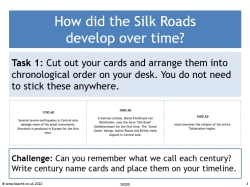How did the Silk Roads develop over time?

This key stage 3 resource reviews key events in the development of the Silk Roads from 3000 BC to the 19th century, furthering students' understanding of the connections between Europe and Central Asia through history. It also provides the opportunity to recap the naming of centuries (e.g. 1 BC – 100 BC = 1st century BC).
Students place cards in order to form a timeline then write a response to the question 'What factors influenced the development of the Silk Roads?', considering trade, religion, war and individuals.
They would benefit from some prior knowledge about who the ‘main players’ in the Silk Roads were, and perhaps who has ruled the areas over time: Classical Rome, Arabic empires, Persia and Persian empires, India, the Mongols, the Ottoman Empire, and China (from the ancient period to modern China).
You might also like the History of the Silk Road Quiz on our sister site Infoplease.
The content of one of the cards:
600 AD
The Eastern Roman Empire becomes the Byzantine Empire. The Tang dynasty rules in China. For the first two centuries, the Silk Roads reach their ‘golden age’. China is very open to foreign cultural influences. Buddhism flourishes. Islam is founded. Muslims control Mesopotamia and Iran, along with the Silk and Spice routes.
